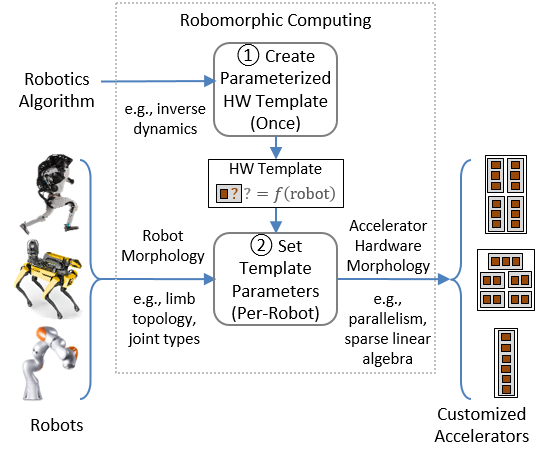Robomorphic Computing: A Design Methodology for Domain-Specific Accelerators Parameterized by Robot Morphology
IEEE Micro Top Picks 2022 Honorable Mention

Robomorphic Computing: A Design Methodology for Domain-Specific Accelerators Parameterized by Robot Morphology
IEEE Micro Top Picks 2022 Honorable MentionAbstract
Robotics applications have hard time constraints and heavy computational burdens that can greatly benefit from domain-specific hardware accelerators. For the latency-critical problem of robot motion planning and control, there exists a performance gap of at least an order of magnitude between joint actuator response rates and state-of-the-art software solutions. Hardware acceleration can close this gap, but it is essential to define automated hardware design flows to keep the design process agile as applications and robot platforms evolve. To address this challenge, we introduce robomorphic computing, a methodology to transform robot morphology into a customized hardware accelerator morphology. We (i) present this design methodology, using robot topology and structure to exploit parallelism and matrix sparsity patterns in accelerator hardware; (ii) use the methodology to generate a parameterized accelerator design for the gradient of rigid body dynamics, a key kernel in motion planning; (iii) evaluate FPGA and synthesized ASIC implementations of this accelerator for an industrial manipulator robot; and (iv) describe how the design can be automatically customized for other robot models. Our FPGA accelerator achieves speedups of 8x and 86x over CPU and GPU when executing a single dynamics gradient computation. It maintains speedups of 1.9x to 2.9x over CPU and GPU, including computation and I/O round-trip latency, when deployed as a coprocessor to a host CPU for processing multiple dynamics gradient computations. ASIC synthesis indicates an additional 7.2x speedup for single computation latency. We describe how this principled approach generalizes to more complex robot platforms, such as quadrupeds and humanoids, as well as to other computational kernels in robotics, outlining a path forward for future robomorphic computing accelerators.